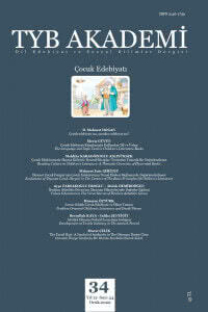Necip Fazıl’ın “Çile” Şiirine Nurettin Topçu’nun “Estetik İman” Kavramı Çerçevesinden Bir Bakış
Nurettin Topçu’nun İsyan Ahlâkı adlı eserindeki “Estetik İman” bölümü hem imana estetik açıdan yorum getirmeye çalışırken hem de estetiği iman açısından yorumlama çabasında olan nadir metinlerdendir. Nurettin Topçu “Estetik İman” bahsinde hakiki sanatçıdaki teslimiyete dikkati çekerek sanatta vecd, çile, sancı ve aşkınlık kavramlarını vurgulamıştır. Nurettin Topçu’nun “Estetik İman” bahsinde konu edindiği hususların birçoğu Necip Fazıl Kısakürek’in şiir anlayışıyla paralellikler göstermektedir. Bilhassa her ikisinde de maddeciliğin reddiyesi ve maddenin karşısına ruhun çıkarılması dikkate değerdir. Ayrıca Nurettin Topçu “Estetik İman”dan bahsederken insandaki yaratıcı melekeye de dikkatleri çekmiştir. Bu yaratıcı meleke, Necip Fazıl’da bir dönüşümün tetiklemesiyle en ileri düzeyde hissedilmiştir. Hem Nurettin Topçu hem de Necip Fazıl imanda ve sanatta bireyin kendi içsel yolculuğunu yani maddeden metafiziğe geçişi vurgulamışlardır. Bu çalışma Nurettin Topçu’nun söz konusu görüşlerinden ve Necip Fazıl’ın “Çile” şiirinden hareketle sanattaki iman, çile, vecd ve aşkınlık kavramlarını irdelemektedir.
Necip Fazil’s “Çile” Poem A Look at the Concept of Aesthetic Faith by Nurettin Topçu
The “Aesthetic Belief” section of Nurettin Topçu’s “İsyan Ahlâkı” is rare texts that both attempt to interpret from the point of view of aesthetics, but also from the point of view of aesthetic belief. Nurettin Topçu emphasizes the concept of “Aesthetic Belief” in the art of delivering attention to the real artist, attracting the arts, and the concepts of sadness and pain and transcendence. Many of the points that Nurettin Topçu mentions about “Aesthetic Belief” are parallel to Necip Fazıl Kısakürek’s poetry understanding. In both of these, it is noteworthy that the rejection of materiality and the prominence of the soul in the face of the material. Nurettin Topçu also referred to the “Aesthetic Belief”, but also attracted attention to the creative proficiency on the human side. This creative mind was felt at the most advanced level, triggering a transformation in Necip Fazıl. Both Nurettin Topçu and Necip Fazıl emphasized the passage of the individual’s own inner journey from material to metaphysical in art and faith. This study examines the concepts of faith, ordeal, ecstasy, and transcendence in nature, based on the principles of the Nurettin Topçu and the poetry of Necip Fazıl’s “Çile”.
___
- Adair, John, The Art of Creative Thinking, Kohan Page, London and Philadelphia 2007.
- Beyatlı, Yahya Kemal, Kendi Gök Kubbemiz, 5. Baskı, İstanbul 1974.
- J.A. Cuddon, A Dictionary of Literary Terms and Literary Theory, Fifth Edition,West Sussex-UK 1913.
- Karakoç, Sezai, Edebiyat Yazıları I-Medeniyetin Rüyası Rüyanın Medeniyeti Şiir, 8. Baskı, İstanbul 2017
- Kısakürek, Necip Fazıl, Çile, Büyük Doğu Yayınları, İstanbul 2017.
- Okay, M. Orhan, Necip Fazıl-Sıcak Yarada Kezzap, Dergâh Yayınları, İstanbul 2015.
- Topçu, Nurettin, İsyan Ahlâkı, Dergâh Yayınları, İstanbul 2014.
- Wallas, Graham, The Art of Thought, Harcourt, Brace, 1926.
- ISSN: 2146-1759
- Yayın Aralığı: 3
- Başlangıç: 2011
- Yayıncı: Mustafa Ekici
Sayıdaki Diğer Makaleler
Leylâ Erbil’in Üç Başlı Ejderha Novellasında Estetik ve Biçim
Necip Fazıl’ın “Çile” Şiirine Nurettin Topçu’nun “Estetik İman” Kavramı Çerçevesinden Bir Bakış
Topkapı Sarayı’nın Yitip Giden Yapılarından Yalı Kasrı
Evveliyatta “Güzel” Var İdi İş Bu “Estetik” Sözü Yeni Çıktı
